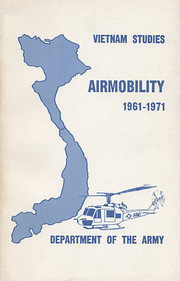

Pulse en una miniatura para ir a Google Books.
|
Cargando... Airmobility, 1961-1971por John J. Tolson, John Tolson
Ninguno Actualmente no hay Conversaciones sobre este libro.  sin reseñas | añadir una reseña
[Includes 2 charts, 12 maps, and 41 illustrations] Although troops had been dropped by parachute since the early years of the Second World War, the use of helicopters to move large number of troops only came to the fore in the years before the Vietnam War. During the Vietnam War they would prove their value in allowing the American troops tactical flexibility, surprise and most of all mobility that the dense terrain and difficult communications of Vietnam complicated. "The author of this monograph, Lieutenant General John J. Tolson, has been involved with the airmobile concept since June 1939, when he participated in the first tactical air movement of ground forces by the U.S. Army. Participating in all the combat jumps of the 503d Parachute Infantry Regiment during World War II, he became an Army aviator in 1957, and later served as Director of Army Aviation and Commandant of the U.S. Army Aviation School. From April 1967 to July 1968 he served as Commanding General, 1st Cavalry Division (Airmobile), Vietnam." As the author himself says in his preface; "Although Vietnam was the first large combat test of airmobility, air assault operations in Southeast Asia would not have been possible without certain key decisions a decade earlier. This study attempts to trace the most important milestones which led to the eventual Formation of airmobile divisions. "It would be impossible in a single volume to adequately describe every airmobile operation in Vietnam during the years 1961-1971. Therefore, only selected operations have been chosen as examples of different airmobile tactics. Many of these were selected because of the author's personal knowledge. Another author might have selected different operations. "I believe I'd be remiss in this account if I were not candid with the reader on some of the pros and cons of airmobility. Thus, throughout the text, I have inserted comments that are intended to broaden the reader's view of this issue." No se han encontrado descripciones de biblioteca. |
Debates activosNingunoCubiertas populares
 Google Books — Cargando... Google Books — Cargando...GénerosSistema Decimal Melvil (DDC)358.4Social sciences Public Administration, Military Science Air forces and other advanced weaponry Air ForcesClasificación de la Biblioteca del CongresoValoraciónPromedio: (2) (2)
¿Eres tú?Conviértete en un Autor de LibraryThing. |
||||||||||||||||||||||||||||||||||||||||||||||||||||||||||||||||||||||||||||||||||||||||||||||||||||||||||||||||||||||||